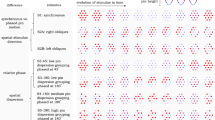Abstract
Tactile detection of surface features of objects is essential for successful exploration and manipulation of our environment. Primates predominantly use fingerpads for exploring small features, owing to the high density of cutaneous mechanoreceptors (Johansson and Vallbo, 1979; Darian-Smith and Renins, 1980) which results in high spatial resolution, as well as due to the dexterity and fine motion control achieved with multiple degrees of freedom to move the fingertip. For humans, the normal contact forces used and the compliance of the fingertip result in contact regions whose overall diameter measures about a centimeter. At any time during contact, the information conveyed by cutaneous mechanoreceptors pertain only to the features within the contact region, thereby limiting the largest lengthscale of the surface features represented in cutaneous information to be of the order of centimeters. The smallest lengthscale is governed by the response thresholds of mechanoreceptors, which can be as low as fractions of a micron (LaMotte and Srinivasan, 1990). In this article we are concerned with millimeter to centimeter sized surface features of rigid objects, the shape of which can be detected from purely cutaneous information.
Preview
Unable to display preview. Download preview PDF.
Similar content being viewed by others
References
Boussinesq, J. (1885). Application des Potentials a l’Etude de TEguilibre et du Mouvement des Solides Elastiques, Gauthier-Villars, Paris.
Darian-Smith, I. and Kenins, P. (1980). Innervation density of mechanoreceptive fibers supplying glabrous skin of the monkey’s index finger. J. Physiol. (Lond). 309. 147–155.
Gauss, C.F. (1827). Disquisitiones generates circa superficies curvas. Commentationes Societatis Regiae Scientiarum Gottingenesis Recentiores. 6, 99–146.
Gladwell, G.M.L. (1980). Contact problems in the classical theory of elasticity. Sijthoff and Noordhoff, Alphen aan den Rijn, The Netherlands.
Hertz, H.R. (1881). Ueber die Berührung fester elastischer Körper. J. reine u. angewandte Math. 92, 156–171. Also, Paper 5 of Volume 1 of collected works.
Horn, B.K.P. (1986). Robot Vision. M.I.T. Press, Cambridge, U.S.A.
Johansson, R.S. and Vallbo, A.B. (1979). Tactile sensibility in the human hand: Relative and absolute densities of four types of mechanoreceptive units in glabrous skin. J. Physiol. (Lond). 286, 283–300.
Knibestöl, M. (1973). Stimulus-response functions of rapidly adapting mechanoreceptors in the human glabrous skin area. J. Physiol. (Lond). 232, 427–452.
Knibestöl, M. (1975). Stimulus-response functions of slowly adapting mechanoreceptors in the human glabrous skin area. J. Physiol. (Lond). 245, 63–80.
LaMotte, R.H. and Srinivasan, M.A. (1987a). Tactile discrimination of shape: Responses of slowly adapting mechanoreceptive afferents to a step stroked across the monkey fingerpad. J. Neuroscience. 7, 1655–1671.
LaMotte, R.H. and Srinivasan, M.A. (1987b). Tactile discrimination of shape: Responses of rapidly adapting mechanoreceptive afferents to a step stroked across the monkey fingerpad. J. Neuroscience. 7, 1672–1681.
LaMotte, R.H. and Srinivasan, M.A. (1990). Surface microgeometry: tactile perception and neural encoding. This volume.
Phillips, J.R. and Johnson, K.O. (1981a). Tactile spatial resolution II. Neural representation of bars, edges, and gratings in monkey primary afferents. J. Neurophysiol. 46, 1192–1203.
Phillips, J.R. and Johnson, K.O. (1981b). Tactile spatial resolution III. A continuum mechanics model of skin predicting mechanoreceptor responses to bars, edges, and gratings. J. Neurophysiol. 46, 1204–1225.
Pubols, B.H. Jr. and Pubols, L.M. (1976). Coding of mechanical stimulus velocity and indentation depth by squirrel monkey and raccoon glabrous skin mechanoreceptors. J. Neurophysiol. 39, 773–787.
Srinivasan, M.A. (1989). Tactile sensing in humans and robots: Computational theory and algorithms. Newman Lab. Tech. Report, Dept. of Mech. Eng., M.I.T., Cambridge, U.S.A.
Srinivasan, M.A. and LaMotte, R.H. (1987). Tactile discrimination of shape: Responses of slowly and rapidly adapting mechanoreceptive afferents to a step indented into the monkey fingerpad. J. Neuroscience. 7, 1682–1697.
Editor information
Editors and Affiliations
Copyright information
© 1991 Macmillan Publishers Limited
About this chapter
Cite this chapter
Srinivasan, M.A., LaMotte, R.H. (1991). Encoding of Shape in the Responses of Cutaneous Mechanoreceptors. In: Franzén, O., Westman, J. (eds) Information Processing in the Somatosensory System. Wenner-Gren Center International Symposium Series. Palgrave, London. https://doi.org/10.1007/978-1-349-11597-6_5
Download citation
DOI: https://doi.org/10.1007/978-1-349-11597-6_5
Publisher Name: Palgrave, London
Print ISBN: 978-1-349-11599-0
Online ISBN: 978-1-349-11597-6
eBook Packages: EngineeringEngineering (R0)




